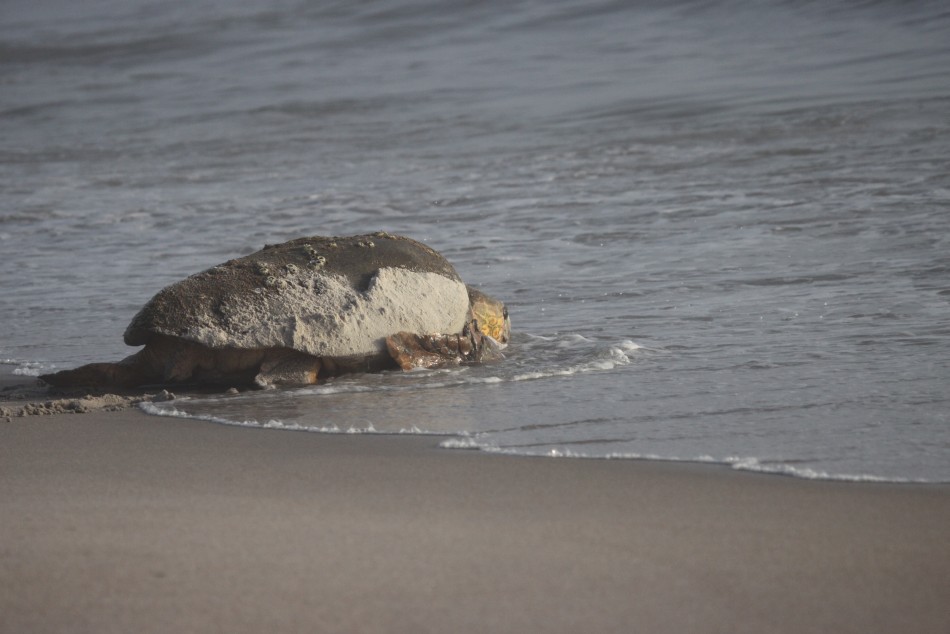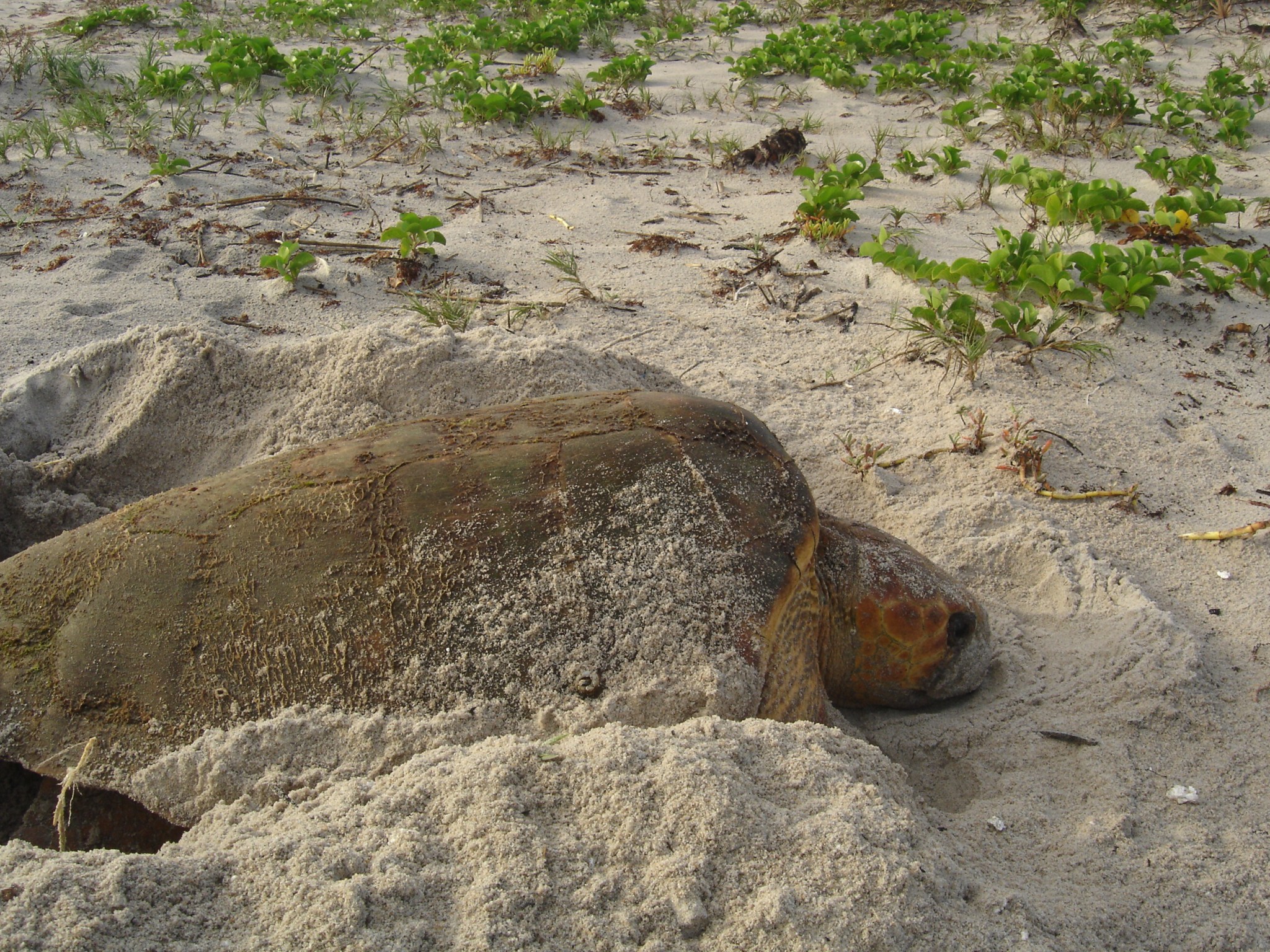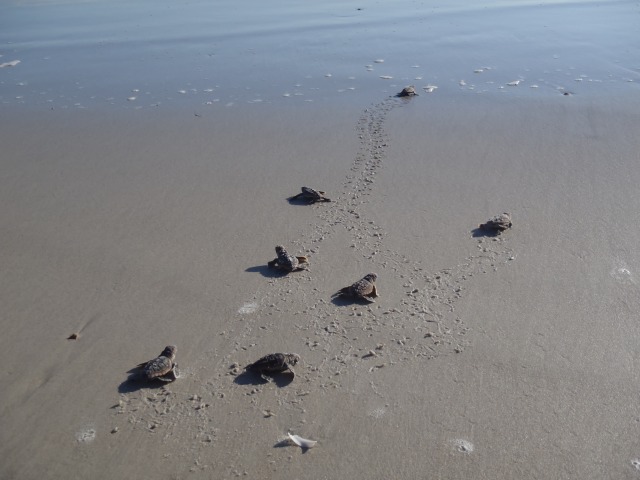They generally only come out at night. And if the timing is right, you may catch a glimpse of a sea turtle lumbering onto the shoreline along Florida’s space coast in search of a place to lay its precious cargo of eggs.
There currently are only seven different species of sea turtles in the world, varying in size from the small Kemp’s Ridley to the very large Leatherback that can weigh more than 1,000 pounds and reach eight feet in length. Along with these, the most prevalent sea turtles that appear in Florida include the Loggerhead and Green. The Hawksbill and Olive Ridley are rarely seen nesting in Florida. The Flatback lives in Australia and the south Pacific. All are on the endangered species list except for the Loggerhead, which is listed as threatened.

Sea turtle nesting and hatching season in Florida generally runs from May to November. These gentle creatures need dark skies and that means lights out in the evening, not just at Kennedy Space Center but all along the eastern seaboard of Florida.
According to Jane Provancha, a wildlife ecologist with InoMedic Health Applications (IHA), more than 5,000 turtles nest on Kennedy’s protected beach, as well as on a portion of the Canaveral National Seashore next to the center.
“For sea turtles, the beach is the most important factor in the reproductive phase of their life history. They need near–shore access and sand that’s in good shape for constructing their nests.” Provancha said. “And they have to have darkness.”
To help employees become more aware of sea turtle nesting habits and Kennedy’s efforts to achieve lights out at night, the Environmental Management Branch of the Center Operations Directorate held a Dark Skies workshop May 30.
“The mission of the International Dark Sky Association (IDA) is to preserve and protect the nighttime environment and our heritage of dark skies through environmentally responsible outdoor lighting,” said Taylor Pitcock, a NASA environmental specialist. “The purpose of the Dark Skies workshop is to improve awareness and make positive changes in Kennedy’s lighting.”

Several presenters covered topics including U.S. Fish and Wildlife Services regulations, exterior lighting compliance and Kennedy’s light management plan as it relates to sea turtle nesting season and energy savings.
“Kennedy strives to minimize light pollution in any way possible,” said Nancy Bray, director of Center Operations. “We incorporate appropriate turtle-friendly lighting into the planning and execution of all our construction projects, and we strive to identify opportunities to update existing lights to meet the federal and state mandates.”
Sea turtles have a very complex life cycle. They can take 20 to 30 years to mature and be able to reproduce. The beach is a really critical part of that cycle because that’s where sea turtles lay their eggs to incubate. It would be very detrimental to the population if the beach habitat were not intact.
Lighting can interfere with females finding their way back to the water. Tonya Long, with the Florida Fish and Wildlife Conservation Commission said during surveys, she’s seen turtle crawls that went half a mile down the beach before they’ve got back to the water. Think about a 250- to 300-pound sea turtle pulling itself along to near exhaustion. Disoriented female turtles have ended up in homeowners’ pools, on back porches, and unfortunately, sometimes they end up in the road.
Bright lights also can have a negative effect on turtle hatchlings. They rely on multiple visual cues to make their way from the nest to the water. They search for the brightest open horizon, which usually is the water illuminated by the moon.
The hatchlings have limited energy to make it offshore. They make a beeline to the water in a “v” formation. Any delay on the beach can result in increased dehydration, exhaustion, predators and death.
Many counties in Florida have lighting ordinances in place and have developed turtle lighting guidelines.
Kennedy’s external lighting guidelines are not new, according to Lynne Phillips, in the center’s Environmental Branch. In fact, they’ve been around since 1995 in various forms. The center’s updated lighting plan focuses on light trespass (interior lighting that can be seen from the exterior).

“Since that time, we’ve had a lot of success with the use of low pressure sodium (LPS), but we’ve also adopted the use of light emitting diodes (LED) more recently,” Phillips said. “Center Operations has done very well incorporating this guidance into our new construction of facilities and retrofitting older facilities, parking lots and outdoor lighting.”
Remember these three Golden Rules for lighting, Long said. First, keep the light source’s height low to minimize light trespass, and use only the lumens output needed. Lighting sources that are lower to the ground make it easier to direct the light to where it is most needed.
Second, the light source should be shielded. Long recommends the use of full cutoff or fully recessed fixtures. The key is to shield the light so it is not visible from the beach.
Third, the light source should produce light with a long wavelength, because sea turtles are attracted to short wavelength lights. In other words, use “wildlife-friendly” bulbs with wavelengths greater than 560 nanometers. Amber, orange and red LED lights produce shine in these wavelength regions.
“Whether you live on the beach or not, it’s really important to follow all of these rules, because the way that you set up the lights at your own home really can affect wildlife in areas that you wouldn’t even think about,” Long said.
The types of fixtures not recommended are lights categorized as decorative, water feature, pond, private balcony, dune cross-over, fountain and tree strap-down if they can be seen from the beach. Some ways to correct or retrofit existing problems include disconnecting and turning off lights; changing lamps to red, orange or amber LEDs; installing 180-degree shields to block light visible from the beach; and installing a fixture that directs light down and away from the beach.
Balancing safety, security and sea turtles is a challenge. Long said there is some misconception that if the light is bigger and brighter then you’re secure, and that’s not necessarily the case.
“You can apply these same principles and have very good security on your property,” Long said. “We’re not trying to advocate that everybody turn off all of their lights and live in total darkness. We’re trying to advocate that the light is focused and used appropriately.”
More resources are listed on their website at http://www.myfwc.com under Wildlife & Habitats.
Shannon Gann, a wildlife ecologist with (IHA), talked about how workers at the center can improve lighting and make a lasting impact and difference in the life history of all wildlife, including sea turtles.
Kennedy and the Merritt Island National Wildlife Refuge have a high biodiversity and more federally protected species than any other preserve in the continental United States. Merritt Island is in the transition zone between the Carolinian and Caribbean zoogeographic provinces.
Lights from nearby facilities can illuminate the beach. Gann said they also found that naturally dark areas can be affected by urban lights and the resulting sky glow. To block as much light as possible, many facilities turn out their lights.
“One hatchling in a thousand will make it to the reproductive stage,” Gann said. “The Kennedy beaches must be preserved to help the sea turtle species to survive. Before you leave the office in the afternoon, flip off the lights or draw the shades. This actually will make a difference in the amount of light that shines out to the beach.”
For information on the Dark Sky Association, visit http://www.darksky.org.

























